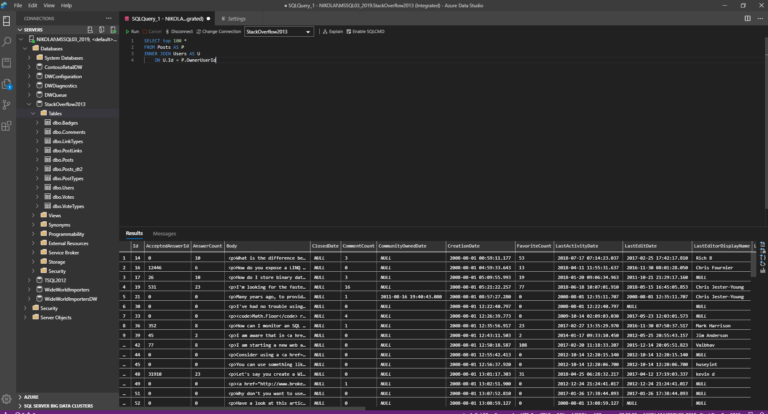
- SSMS AZURE DATA STUDIO HOW TO
- SSMS AZURE DATA STUDIO UPDATE
- SSMS AZURE DATA STUDIO PRO
- SSMS AZURE DATA STUDIO CODE
SSMS AZURE DATA STUDIO HOW TO
How to use Azure Data Studio with a SQL Source Control projectįortunately, with SQL Compare, the team’s SQL source control project can move with them. However, times have changed, and many developers now make database changes in ADS. It also had one-click check-ins, rather than relying on external VCS clients.įast forward ten years and SQL Source Control remains a versatile yet simple interface between a SQL Server development database and version control. It made it much easier for teams to spot potentially conflicting changes to the same object, and therefore to avoid merge conflicts.

It adopted SQL Compare’s comparison engine and the scripts folder workflow, integrated it tightly into SSMS, and improved it. Given the dominance of SQL Server Management Studio, SQL Source Control was SQL Compare’s natural successor.

Teams could maintain the latest database version alongside the corresponding application code, and these changes would make their way together to production in a much more controlled fashion. In this folder, SQL Compare would now create and maintain a hierarchy of object creation scripts (.sql) in sub folders, by object type.
SSMS AZURE DATA STUDIO PRO
No, this wasn’t SQL Source Control, but SQL Compare Pro v6, which introduced support for running schema comparisons with a scripts folder as the source or target, in addition to databases.ĭatabase developers would modify their development database, as they had done before, but rather than deploy these changes directly to another database, such as Staging or Production, they would instead save the changes to the scripts folder. Redgate released its first database version control tool in 2007.

Schema comparisons and SQL script generation
SSMS AZURE DATA STUDIO UPDATE
They will want to use the existing Source Control project as the starting point for continued development work in ADS, and they will still need a way to modify their development databases, and then update the version control repository with their latest changes.įortunately, SQL Compare makes this process very easy. So, what does this mean for database developers who previously relied on SSMS add-ins, such as SQL Source Control? If all work on a project is moving to Azure Data Studio, for example, then requiring database developers to run SSMS alongside it, just to manage their SQL Source Control projects somewhat defeats the point. For some developments, and some developers, the newer breeds of SQL editor, with attractive features such as Notebook support, are increasingly credible alternatives. While SQL Server Management Studio remains the most popular IDE for working with SQL Server, it’s also becoming more common that it’s not the only IDE teams use.

Which editors do you use when working with SQL Server?
SSMS AZURE DATA STUDIO CODE
Azure Data Studio and VS Code now represent over 15% of editor usage according to a recent SQL Server Central poll. Over the past couple of years, we’ve seen a steady rise in the popularity of fast, lightweight IDEs that run on multiple platforms. The rise of lightweight, cross-platform IDEs How smooth will the transition be? How easy will it be to transfer or replicate their existing processes for Git database version control, for example? With Azure Data Studio’s tight integration with Git and a tool like SQL Compare, it should be straightforward. Many of these teams have been weighing the benefits of moving to a multi-platform IDE for SQL Server, such as Azure Data Studio. Many development teams have been developing SQL Server databases for many years, working mainly in SQL Server Management Studio.


 0 kommentar(er)
0 kommentar(er)
